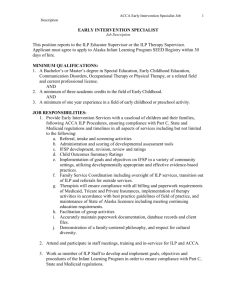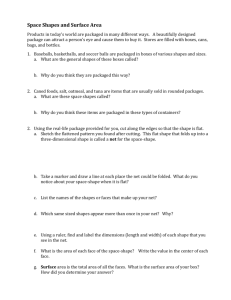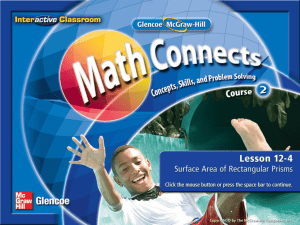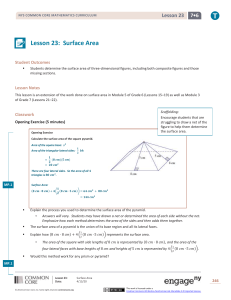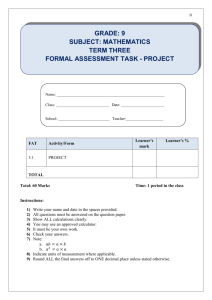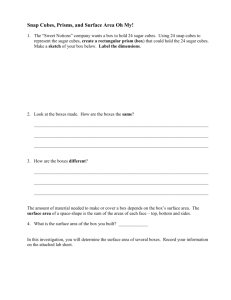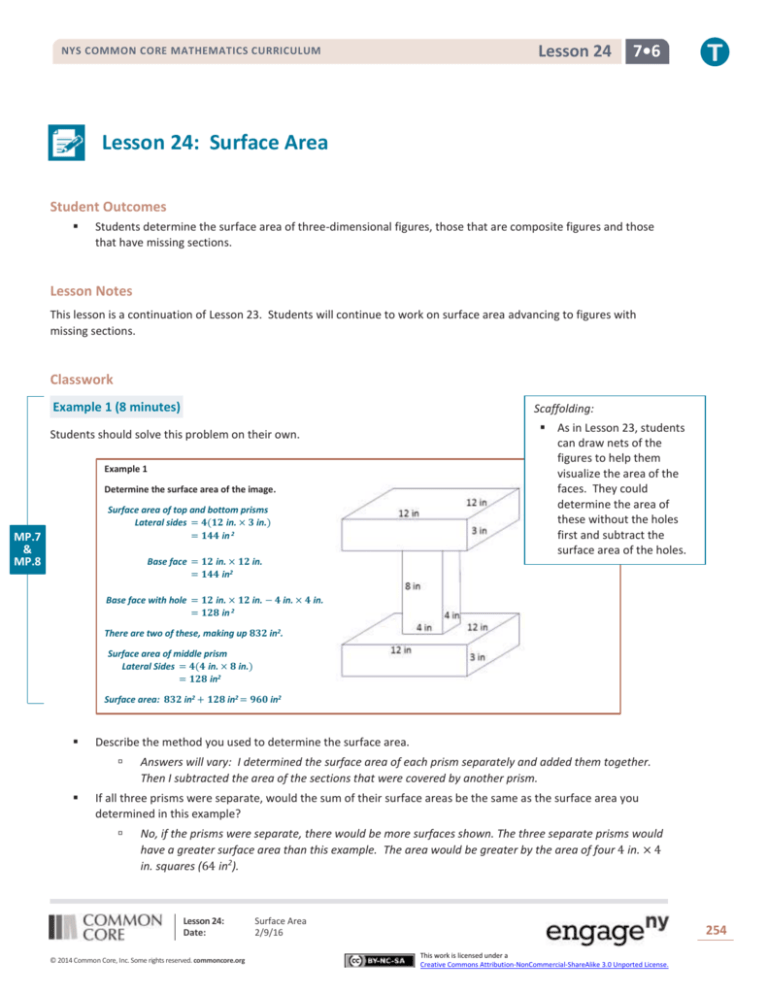
NYS COMMON CORE MATHEMATICS CURRICULUM
Lesson 24
7•6
Lesson 24: Surface Area
Student Outcomes
Students determine the surface area of three-dimensional figures, those that are composite figures and those
that have missing sections.
Lesson Notes
This lesson is a continuation of Lesson 23. Students will continue to work on surface area advancing to figures with
missing sections.
Classwork
Example 1 (8 minutes)
Scaffolding:
Students should solve this problem on their own.
Example 1
Determine the surface area of the image.
Surface area of top and bottom prisms
Lateral sides = 𝟒(𝟏𝟐 in. × 𝟑 in.)
= 𝟏𝟒𝟒 in 2
MP.7
&
MP.8
Base face = 𝟏𝟐 in. × 𝟏𝟐 in.
= 𝟏𝟒𝟒 in2
As in Lesson 23, students
can draw nets of the
figures to help them
visualize the area of the
faces. They could
determine the area of
these without the holes
first and subtract the
surface area of the holes.
Base face with hole = 𝟏𝟐 in. × 𝟏𝟐 in. − 𝟒 in. × 𝟒 in.
= 𝟏𝟐𝟖 in 2
There are two of these, making up 𝟖𝟑𝟐 in2.
Surface area of middle prism
Lateral Sides = 𝟒(𝟒 in. × 𝟖 in.)
= 𝟏𝟐𝟖 in2
Surface area: 𝟖𝟑𝟐 in2 + 𝟏𝟐𝟖 in2 = 𝟗𝟔𝟎 in2
Describe the method you used to determine the surface area.
Answers will vary: I determined the surface area of each prism separately and added them together.
Then I subtracted the area of the sections that were covered by another prism.
If all three prisms were separate, would the sum of their surface areas be the same as the surface area you
determined in this example?
No, if the prisms were separate, there would be more surfaces shown. The three separate prisms would
have a greater surface area than this example. The area would be greater by the area of four 4 in. × 4
in. squares (64 in2).
Lesson 24:
Date:
© 2014 Common Core, Inc. Some rights reserved. commoncore.org
Surface Area
2/9/16
254
This work is licensed under a
Creative Commons Attribution-NonCommercial-ShareAlike 3.0 Unported License.
Lesson 24
NYS COMMON CORE MATHEMATICS CURRICULUM
Example 2 (5 minutes)
Scaffolding:
Example 2
a.
Determine the surface area of the cube.
𝑺𝒖𝒓𝒇𝒂𝒄𝒆 𝒂𝒓𝒆𝒂 = 𝟔𝒔𝟐
𝑺𝑨 = 𝟔(𝟏𝟐 𝒊𝒏)𝟐
𝑺𝑨 = 𝟔(𝟏𝟒𝟒 𝒊𝒏𝟐 )
𝑺𝑨 = 𝟖𝟔𝟒 𝒊𝒏𝟐
7•6
As in Lesson 23, students
can draw nets of the
figures to help them
visualize the area of the
faces. They could
determine the area of
these without the holes
first and subtract the
surface area of the holes.
Explain how 6(12 in.)2 represents the surface area of the cube.
The area of one face, one square with side length of 12 in., is (12 in. )2 , and so a total area of all six
faces is 6(12 in. )2 .
A square hole with a side length of 𝟒 inches is drilled through the cube. Determine the new surface area.
b.
Area of interior lateral sides
= 𝟒(𝟏𝟐 in. × 𝟒 in.)
= 𝟏𝟗𝟐 in2
Surface Area of cube with holes
𝟐
= 𝟔(𝟏𝟐 in.) − 𝟐(𝟒 in. × 𝟒 in.) + 𝟒(𝟏𝟐 in. × 𝟒 in. )
= 𝟖𝟔𝟒 in2 − 𝟑𝟐 in2 + 𝟏𝟗𝟐 in2
= 𝟏, 𝟎𝟐𝟒 in2
How does drilling a hole in the cube change the surface area?
What happens to the surfaces that now show inside the cube?
A rectangular prism was drilled out of the cube with the following dimensions: 4 in. × 4 in. × 12 in.
How can we use this to help us determine the new total surface area?
These are now part of the surface area.
What is the shape of the piece that was removed from the cube?
We have to subtract the area of the square at the surface from each end.
We can find the surface area of the cube and the surface area of the rectangular prism, but we will
have to subtract the area of the square bases from the cube and also exclude these bases in the area of
the rectangular prism.
Why is the surface area larger when holes have been cut into the cube?
There are more surfaces showing now. All of the surfaces need to be included in the surface area.
Lesson 24:
Date:
© 2014 Common Core, Inc. Some rights reserved. commoncore.org
Surface Area
2/9/16
255
This work is licensed under a
Creative Commons Attribution-NonCommercial-ShareAlike 3.0 Unported License.
Lesson 24
NYS COMMON CORE MATHEMATICS CURRICULUM
7•6
Explain how the expression 6(12 in.)2 − 2(4 in. × 4 in.) + 4(12 in. × 4 in.) represents the surface area of the
cube with the hole.
From the total surface area of a whole (uncut) cube, 6(12 in.)2 , the area of the bases (the cuts made to
the surface of the cube) are subtracted: 6(12 in.)2 − 2(4 in. × 4 in.). To this expression we add the
area of the four lateral faces of the cut out prism, 4(12 in. × 4 in.). The complete expression then is
6(12 in. )2 − 2(4 in. × 4 in.) + 4(12 in. × 4 in.).
Example 3 (5 minutes)
Example 3
A right rectangular pyramid has a square base with a side length of 𝟏𝟎 inches. The surface area of the pyramid is 𝟐𝟔𝟎 in2.
Find the height of the four lateral triangular faces.
Area of base = 𝟏𝟎 in. × 𝟏𝟎 in.
= 𝟏𝟎𝟎 in 2
Area of the four faces = 𝟐𝟔𝟎 in2 − 𝟏𝟎𝟎 in2
= 𝟏𝟔𝟎 in2
The total area of the four faces is 𝟏𝟔𝟎 in2. Therefore, the area of each triangular faces is 𝟒𝟎 in 2.
𝟏
Area of lateral side = 𝒃𝒉
𝟐
𝟏
𝟐
𝟒𝟎 𝒊𝒏 = (𝟏𝟎 𝒊𝒏. )𝒉
𝟐
𝟒𝟎 𝒊𝒏𝟐 = (𝟓 𝒊𝒏. )𝒉
𝒉 = 𝟖 𝒊𝒏.
The height of each lateral triangular face is 𝟖 inches.
What strategies could you use to help you solve this problem?
I could draw a picture of the pyramid and label the sides so that I can visualize what the problem is
asking me to do.
What information have we been given? How can we use the information?
We know the total surface area, and we know the length of the sides of the square.
We can use the length of the sides of the square to give us the area of the square base.
How will the area of the base help us determine the slant height?
First, we can subtract the area of the base from the total surface area in order to determine what is left
for the lateral sides.
Now we can divide the remaining area by 4 to get the area of just one triangular face.
Finally, we can work backwards. We have the area of the triangle, and we know the base is 10 in., so
we can solve for the height.
Lesson 24:
Date:
© 2014 Common Core, Inc. Some rights reserved. commoncore.org
Surface Area
2/9/16
256
This work is licensed under a
Creative Commons Attribution-NonCommercial-ShareAlike 3.0 Unported License.
Lesson 24
NYS COMMON CORE MATHEMATICS CURRICULUM
7•6
Exercises 1–8 (20 minutes)
Students work in pairs to complete the exercises.
Exercises 1–8
Determine the surface area of each figure. Assume all faces are rectangles unless it is indicated otherwise.
1.
Top and bottom = 𝟐(𝟏𝟖 𝒎 × 𝟓 𝒎) = 𝟏𝟖𝟎 𝒎𝟐
Extra interior sides = 𝟐(𝟓 𝒎 × 𝟕 𝒎) = 𝟕𝟎 𝒎𝟐
Left and right sides = 𝟐(𝟓 𝒎 × 𝟏𝟐 𝒎) = 𝟏𝟐𝟎 𝒎𝟐
Front and back sides = 𝟐((𝟏𝟖 𝒎 × 𝟏𝟐 𝒎) − (𝟖 𝒎 × 𝟕 𝒎))
= 𝟐(𝟐𝟏𝟔 𝒎𝟐 − 𝟓𝟔 𝒎𝟐 )
= 𝟐(𝟏𝟔𝟎 𝒎𝟐 )
= 𝟑𝟐𝟎 𝒎𝟐
Surface area = 𝟏𝟖𝟎 𝒎𝟐 + 𝟕𝟎 𝒎𝟐 + 𝟏𝟐𝟎 𝒎𝟐 + 𝟑𝟐𝟎 𝒎𝟐
= 𝟔𝟗𝟎 𝒎𝟐
2.
In addition to your calculation, explain how the surface area was determined.
The surface area of the prism is found by taking the sum of the
areas of the trapezoidal front and back areas of the four different
sized rectangles that make up the lateral faces.
Area top = 𝟐𝟓 𝒄𝒎 × 𝟖 𝒄𝒎
= 𝟐𝟎𝟎 𝒄𝒎𝟐
Area bottom = 𝟐𝟒 𝒄𝒎 × 𝟖 𝒄𝒎
= 𝟏𝟗𝟐 𝒄𝒎𝟐
Area sides = (𝟐𝟑 𝒄𝒎 × 𝟖 𝒄𝒎) + (𝟏𝟔 𝒄𝒎 𝟖 𝒄𝒎)
= 𝟑𝟏𝟐 𝒄𝒎𝟐
𝟏
Area front and back = 𝟐 ( (𝟏𝟔 𝒄𝒎 + 𝟐𝟑 𝒄𝒎)(𝟐𝟒 𝒄𝒎))
𝟐
= 𝟐(𝟒𝟔𝟖 𝒄𝒎𝟐 )
= 𝟗𝟑𝟔 𝒄𝒎𝟐
Surface Area = 𝟐𝟎𝟎 𝒄𝒎𝟐 + 𝟏𝟗𝟐 𝒄𝒎𝟐 + 𝟑𝟏𝟐 𝒄𝒎𝟐 + 𝟗𝟑𝟔 𝒄𝒎𝟐
= 𝟏, 𝟔𝟒𝟎 𝒄𝒎𝟐
Lesson 24:
Date:
© 2014 Common Core, Inc. Some rights reserved. commoncore.org
Surface Area
2/9/16
257
This work is licensed under a
Creative Commons Attribution-NonCommercial-ShareAlike 3.0 Unported License.
Lesson 24
NYS COMMON CORE MATHEMATICS CURRICULUM
7•6
3.
Surface Area of Prisms on the Sides:
Area of front and back = 𝟐(𝟐 in. × 𝟏𝟒 in.)
= 𝟓𝟔 in2
Area of top and bottom = 𝟐(𝟐 in. × 𝟏𝟎 in.)
= 𝟒𝟎 in2
Area of side = 𝟏𝟒 in. × 𝟏𝟎 in. = 𝟏𝟒𝟎 in2
Area of side with hole = 𝟏𝟒 in. × 𝟏𝟎 in. − 𝟑 in. × 𝟑 in.
= 𝟏𝟑𝟏 in2
There are two such rectangular prisms, so the surface area of both is 𝟕𝟑𝟒 in2.
Surface Area of Middle Prism:
Area of front and back = 𝟐(𝟑 in. × 𝟏𝟐 in.) = 𝟕𝟐 in2
Area of sides = 𝟐(𝟑 in. × 𝟏𝟐 in.) = 𝟕𝟐 in2
Surface area = 𝟕𝟑𝟒 in2 + 𝟏𝟒𝟒 in2 = 𝟖𝟕𝟖 in2
4.
In addition to your calculation, explain how the surface area was determined.
The surface area of the prism is found by taking the area of the base of the
rectangular prism and the area of its four lateral faces and adding it to the
area of the four lateral faces of the pyramid.
Area of base = 𝟗 𝒇𝒕.× 𝟗 𝒇𝒕.
= 𝟖𝟏 𝒇𝒕𝟐
Area of rectangular sides = 𝟒(𝟗 𝒇𝒕.× 𝟓 𝒇𝒕. )
= 𝟏𝟖𝟎 𝒇𝒕𝟐
𝟏
Area of triangular sides = 𝟒 ( (𝟗 𝒇𝒕. )(𝟔 𝒇𝒕. ))
𝟐
= 𝟏𝟎𝟖 𝒇𝒕𝟐
Surface Area = 𝟖𝟏 𝒇𝒕𝟐 + 𝟏𝟖𝟎 𝒇𝒕𝟐 + 𝟏𝟎𝟖 𝒇𝒕𝟐
= 𝟑𝟔𝟗 𝒇𝒕𝟐
5.
A hexagonal prism has the following base and has a
height of 𝟖 units. Determine the surface area of the
prism.
Area of bases = 𝟐(𝟒𝟖 + 𝟔 + 𝟐𝟎 + 𝟏𝟎) units2
= 𝟏𝟔𝟖 units2
Area of 𝟓 unit sides = 𝟒(𝟓 × 𝟖) units2
= 𝟏𝟔𝟎 units2
Area of other sides = (𝟒 × 𝟖) units2 + (𝟏𝟐 × 𝟖) units2
= 𝟏𝟐𝟖 units2
Surface Area = 𝟏𝟔𝟖 units2 + 𝟏𝟔𝟎 units2 + 𝟏𝟐𝟖 units2
= 𝟒𝟓𝟔 units2
Lesson 24:
Date:
© 2014 Common Core, Inc. Some rights reserved. commoncore.org
Surface Area
2/9/16
258
This work is licensed under a
Creative Commons Attribution-NonCommercial-ShareAlike 3.0 Unported License.
Lesson 24
NYS COMMON CORE MATHEMATICS CURRICULUM
6.
7•6
Determine the surface area of each figure.
a.
𝑺𝑨 = 𝟔𝒔𝟐
= 𝟔(𝟗 m)𝟐
= 𝟔(𝟖𝟏 m2)
= 𝟒𝟖𝟔 m2
b.
A cube with a square hole with 𝟑 m side lengths has been drilled through the cube.
Lateral sides of the hole = 𝟒(𝟗 m × 𝟑 m) = 𝟏𝟎𝟖 m2
Surface area of cube with holes = 𝟒𝟖𝟔 m2 − 𝟐(𝟑 m × 𝟑 m) + 𝟏𝟎𝟖 m2 =
𝟓𝟕𝟔 m2
c.
A second square hole with 𝟑 m side lengths has been drilled through the cube.
Surface Area = 𝟓𝟕𝟔 m2 − 𝟒(𝟑 m × 𝟑 m) + 𝟐(𝟒(𝟑 m × 𝟑 m))
= 𝟔𝟏𝟐 m2
7.
The figure below shows 𝟐𝟖 cubes with an edge length of 𝟏 unit. Determine the surface area.
Area top and bottom = 𝟐𝟒 units2
Area sides = 𝟏𝟖 units2
Area front and back = 𝟐𝟖 units2
Surface Area = 𝟐𝟒 + 𝟏𝟖 + 𝟐𝟖
= 𝟕𝟎 units2
Lesson 24:
Date:
© 2014 Common Core, Inc. Some rights reserved. commoncore.org
Surface Area
2/9/16
259
This work is licensed under a
Creative Commons Attribution-NonCommercial-ShareAlike 3.0 Unported License.
Lesson 24
NYS COMMON CORE MATHEMATICS CURRICULUM
8.
7•6
The base rectangle of a right rectangular prism is 𝟒 ft. × 𝟔 ft. The surface area is 𝟐𝟖𝟖 ft2. Find the height.
Let 𝒉 be the height in feet.
Area of one base: 𝟒 ft. × 𝟔 ft. = 𝟐𝟒 ft2
Area of two bases: 𝟐(𝟐𝟒 ft2 ) = 𝟒𝟖 ft2
Numeric area of four lateral faces: 𝟐𝟖𝟖 ft2 − 𝟒𝟖 ft2 = 𝟐𝟒𝟎 ft2
Algebraic area of four lateral faces: 𝟐(𝟔𝒉 + 𝟒𝒉)
Solve for 𝒉
𝟐(𝟔𝒉 + 𝟒𝒉) = 𝟐𝟒𝟎
𝟏𝟎𝒉 = 𝟏𝟐𝟎
𝒉 = 𝟏𝟐
The height is 𝟏𝟐 feet.
Closing (2 minutes)
Write down three tips that you would give a friend that is trying to calculate surface area.
Exit Ticket (5 minutes)
Lesson 24:
Date:
© 2014 Common Core, Inc. Some rights reserved. commoncore.org
Surface Area
2/9/16
260
This work is licensed under a
Creative Commons Attribution-NonCommercial-ShareAlike 3.0 Unported License.
Lesson 24
NYS COMMON CORE MATHEMATICS CURRICULUM
Name
7•6
Date
Lesson 24: Surface Area
Exit Ticket
Determine the surface area of the right rectangular prism after the two square holes have been drilled. Explain how you
determined the surface area.
Lesson 24:
Date:
© 2014 Common Core, Inc. Some rights reserved. commoncore.org
Surface Area
2/9/16
261
This work is licensed under a
Creative Commons Attribution-NonCommercial-ShareAlike 3.0 Unported License.
Lesson 24
NYS COMMON CORE MATHEMATICS CURRICULUM
7•6
Exit Ticket Sample Solutions
Determine the surface area of the right rectangular prism after the two square holes have been drilled. Explain how you
determined the surface area.
Area of top and bottom = 𝟐(𝟏𝟓 𝒄𝒎 × 𝟔 𝒄𝒎)
= 𝟏𝟖𝟎 𝒄𝒎𝟐
Area of sides = 𝟐(𝟔 𝒄𝒎 × 𝟖 𝒄𝒎)
= 𝟗𝟔 𝒄𝒎𝟐
Area of front and back = 𝟐(𝟏𝟓 𝒄𝒎 × 𝟖 𝒄𝒎) − 𝟒(𝟓 𝒄𝒎 × 𝟓 𝒄𝒎)
= 𝟏𝟒𝟎 𝒄𝒎𝟐
Area inside = 𝟖(𝟓 𝒄𝒎 × 𝟔 𝒄𝒎)
= 𝟐𝟒𝟎 𝒄𝒎𝟐
Surface Area = 𝟏𝟖𝟎 𝒄𝒎𝟐 + 𝟗𝟔 𝒄𝒎𝟐 + 𝟏𝟒𝟎 𝒄𝒎𝟐 + 𝟐𝟒𝟎 𝒄𝒎𝟐
= 𝟔𝟓𝟔 𝒄𝒎𝟐
Take the sum of the areas of the four lateral faces of the main rectangular prism, and subtract the areas of the four
square cuts from the area of the bases of the main rectangular prism. Finally, add the lateral faces of the prisms that
were cut out of the main prism.
Problem Set Sample Solutions
Determine the surface area of each figure.
1.
In addition to the calculation of the surface area, describe how you found the surface area.
Area of top = 𝟐𝟖 𝒄𝒎 × 𝟏𝟑 𝒄𝒎
= 𝟑𝟔𝟒 𝒄𝒎𝟐
Area of bottom = 𝟐𝟖 𝒄𝒎 × 𝟏𝟐 𝒄𝒎
= 𝟑𝟑𝟔 𝒄𝒎𝟐
Area of left and right sides = 𝟐𝟖 𝒄𝒎 × 𝟐𝟎 𝒄𝒎 + 𝟏𝟓 𝒄𝒎 × 𝟐𝟖 𝒄𝒎
= 𝟗𝟖𝟎 𝒄𝒎𝟐
𝟏
Area of front and back sides = 𝟐 ((𝟏𝟐 𝒄𝒎 × 𝟏𝟓 𝒄𝒎) + (𝟓 𝒄𝒎 × 𝟏𝟐 𝒄𝒎))
𝟐
= 𝟐(𝟏𝟖𝟎 𝒄𝒎𝟐 + 𝟑𝟎 𝒄𝒎𝟐 )
= 𝟐(𝟐𝟏𝟎 𝒄𝒎𝟐 )
= 𝟒𝟐𝟎 𝒄𝒎𝟐
Surface area = 𝟑𝟔𝟒 𝒄𝒎𝟐 + 𝟑𝟑𝟔 𝒄𝒎𝟐 + 𝟗𝟖𝟎 𝒄𝒎𝟐 + 𝟒𝟐𝟎 𝒄𝒎𝟐
= 𝟐, 𝟏𝟎𝟎 𝒄𝒎𝟐
Split the area of the two trapezoidal bases, take the sum of the areas, and then add the areas of the four different
sized rectangles that make up the lateral faces.
Lesson 24:
Date:
© 2014 Common Core, Inc. Some rights reserved. commoncore.org
Surface Area
2/9/16
262
This work is licensed under a
Creative Commons Attribution-NonCommercial-ShareAlike 3.0 Unported License.
Lesson 24
NYS COMMON CORE MATHEMATICS CURRICULUM
2.
7•6
Area of front and back = 𝟐(𝟏𝟖. 𝟒 in. × 𝟖. 𝟔 in.) = 𝟑𝟏𝟔. 𝟒𝟖 in2
Area of sides = 𝟐(𝟖. 𝟔 𝒊𝒏.× 𝟐𝟒 𝒊𝒏. ) = 𝟒𝟏𝟐. 𝟖 𝒊𝒏𝟐
Area of top and bottom =
=
=
=
𝟐((𝟏𝟖. 𝟒 in. × 𝟐𝟒 in.) − 𝟒. 𝟖 in. × 𝟐. 𝟐 in.)
𝟐(𝟒𝟒𝟏. 𝟔 in2 − 𝟏𝟎. 𝟓𝟔 in2)
𝟐(𝟒𝟑𝟏. 𝟎𝟒 in2)
𝟖𝟔𝟐. 𝟎𝟖 in2
Surface Area = 𝟑𝟏𝟔. 𝟒𝟖 in2 + 𝟒𝟏𝟐. 𝟖 in2 + 𝟖𝟔𝟐. 𝟎𝟖 in2
= 𝟏, 𝟓𝟗𝟏. 𝟑𝟔 in2
3.
𝟏
Area of front and back = 𝟐 ( (𝟑𝟐 𝒎 + 𝟏𝟔 𝒎)𝟏𝟓 𝒎)
𝟐
= 𝟕𝟐𝟎 𝒎𝟐
Area of top = 𝟏𝟔 𝒎 × 𝟑𝟔 𝒎
= 𝟓𝟕𝟔 𝒎𝟐
Area of left and right sides = 𝟐(𝟏𝟕 𝒎 × 𝟑𝟔 𝒎)
= 𝟐(𝟔𝟏𝟐 𝒎𝟐 )
= 𝟏, 𝟐𝟐𝟒 𝒎𝟐
32 m
Area of bottom = 𝟑𝟐 𝒎 × 𝟑𝟔 𝒎
= 𝟏, 𝟏𝟓𝟐 𝒎𝟐
Surface Area = 𝟕𝟐𝟎 𝒎𝟐 + 𝟏, 𝟏𝟓𝟐 𝒎𝟐 + 𝟏, 𝟐𝟐𝟒 𝒎𝟐 + 𝟓𝟕𝟔 𝒎𝟐
= 𝟑, 𝟔𝟕𝟐 𝒎𝟐
4.
Determine the surface area after two square holes with a side length of 𝟐 m are drilled through the solid figure
composed of two rectangular prisms.
Surface Area of Top Prism Before the Hole is Drilled:
Area of top = 𝟒 𝒎 × 𝟓 𝒎
= 𝟐𝟎 𝒎𝟐
Area of front and back = 𝟐(𝟒 𝒎 × 𝟓 𝒎)
= 𝟒𝟎 𝒎𝟐
Area of sides = 𝟐(𝟓 𝒎 × 𝟓 𝒎)
= 𝟓𝟎 𝒎𝟐
Surface Area of Bottom Prism Before the Hole is Drilled:
Area of top = 𝟏𝟎 𝒎 × 𝟏𝟎 𝒎 − 𝟐𝟎 𝒎𝟐
= 𝟖𝟎 𝒎𝟐
Area of bottom = 𝟏𝟎 𝒎 × 𝟏𝟎 𝒎
= 𝟏𝟎𝟎 𝒎𝟐
Area of front and back = 𝟐(𝟏𝟎 𝒎 × 𝟑 𝒎)
= 𝟔𝟎 𝒎𝟐
Surface Area of Interiors:
Area of Interiors = 𝟒(𝟐 𝒎 × 𝟒 𝒎) + 𝟒(𝟐 𝒎 × 𝟑 𝒎)
= 𝟓𝟔 𝒎𝟐
Area of sides = 𝟐(𝟏𝟎 𝒎 × 𝟑 𝒎)
= 𝟔𝟎 𝒎𝟐
Surface area = 𝟏𝟏𝟎 𝒎𝟐 + 𝟑𝟎𝟎 𝒎𝟐 + 𝟓𝟔 𝒎𝟐 − 𝟏𝟔 𝒎𝟐 = 𝟒𝟓𝟎 𝒎𝟐
Lesson 24:
Date:
© 2014 Common Core, Inc. Some rights reserved. commoncore.org
Surface Area
2/9/16
263
This work is licensed under a
Creative Commons Attribution-NonCommercial-ShareAlike 3.0 Unported License.
NYS COMMON CORE MATHEMATICS CURRICULUM
5.
Lesson 24
7•6
The base of a right prism is shown below. Determine the surface area if the height of the prism is 𝟏𝟎 cm. Explain
how you determined the surface area.
Take the sum of the areas of the two bases made up of two right triangles, and add to it the sum of the areas of the
lateral faces made up by rectangles of different sizes.
Area of sides
= (𝟐𝟎 𝒄𝒎 × 𝟏𝟎 𝒄𝒎) + (𝟏𝟓 𝒄𝒎 × 𝟏𝟎 𝒄𝒎) + (𝟐𝟒 𝒄𝒎 × 𝟏𝟎 𝒄𝒎) + (𝟕 𝒄𝒎 × 𝟏𝟎 𝒄𝒎)
= 𝟐𝟎𝟎 𝒄𝒎𝟐 + 𝟏𝟓𝟎 𝒄𝒎𝟐 + 𝟐𝟒𝟎 𝒄𝒎𝟐 + 𝟕𝟎 𝒄𝒎𝟐
= 𝟔𝟔𝟎 𝒄𝒎𝟐
Area of bases
𝟏
𝟏
= 𝟐 ( (𝟕 𝒄𝒎 × 𝟐𝟒 𝒄𝒎) + (𝟐𝟎 𝒄𝒎 × 𝟏𝟓 𝒄𝒎))
𝟐
𝟐
= (𝟕 𝒄𝒎 × 𝟐𝟒 𝒄𝒎) + (𝟐𝟎 𝒄𝒎 × 𝟏𝟓 𝒄𝒎)
= 𝟏𝟔𝟖 𝒄𝒎𝟐 + 𝟑𝟎𝟎 𝒄𝒎𝟐
= 𝟒𝟔𝟖 𝒄𝒎𝟐
Surface area
= 𝟔𝟔𝟎 𝒄𝒎𝟐 + 𝟒𝟔𝟖 𝒄𝒎𝟐
= 𝟏, 𝟏𝟐𝟖 𝒄𝒎𝟐
Lesson 24:
Date:
© 2014 Common Core, Inc. Some rights reserved. commoncore.org
Surface Area
2/9/16
264
This work is licensed under a
Creative Commons Attribution-NonCommercial-ShareAlike 3.0 Unported License.




